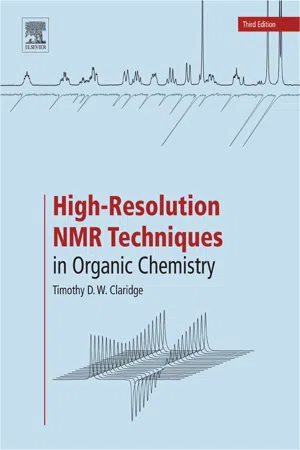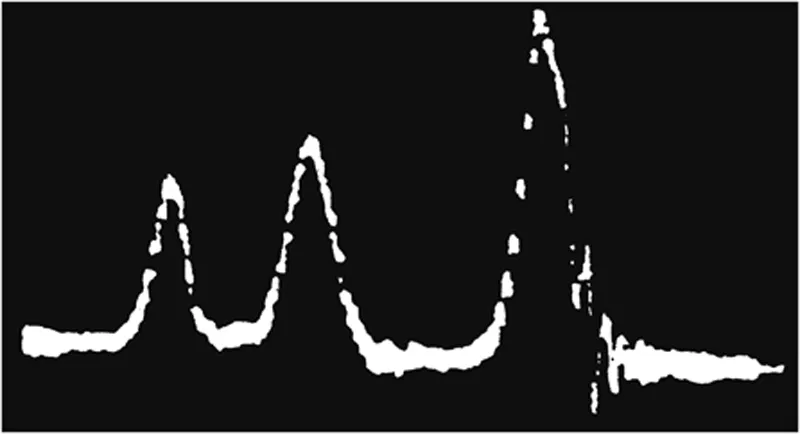
- 552 pages
- English
- ePUB (mobile friendly)
- Available on iOS & Android
High-Resolution NMR Techniques in Organic Chemistry
About this book
High-Resolution NMR Techniques in Organic Chemistry, Third Edition describes the most important NMR spectroscopy techniques for the structure elucidation of organic molecules and the investigation of their behaviour in solution. Appropriate for advanced undergraduate and graduate students, research chemists and NMR facility managers, this thorough revision covers practical aspects of NMR techniques and instrumentation, data collection, and spectrum interpretation. It describes all major classes of one- and two-dimensional NMR experiments including homonuclear and heteronuclear correlations, the nuclear Overhauser effect, diffusion measurements, and techniques for studying protein–ligand interactions. A trusted authority on this critical expertise, High-Resolution NMR Techniques in Organic Chemistry, Third Edition is an essential resource for every chemist and NMR spectroscopist.
Frequently asked questions
- Essential is ideal for learners and professionals who enjoy exploring a wide range of subjects. Access the Essential Library with 800,000+ trusted titles and best-sellers across business, personal growth, and the humanities. Includes unlimited reading time and Standard Read Aloud voice.
- Complete: Perfect for advanced learners and researchers needing full, unrestricted access. Unlock 1.4M+ books across hundreds of subjects, including academic and specialized titles. The Complete Plan also includes advanced features like Premium Read Aloud and Research Assistant.
Please note we cannot support devices running on iOS 13 and Android 7 or earlier. Learn more about using the app.
Information
Introduction
Abstract
Keywords
1.1. The development of high-resolution NMR
| Decade | Notable Advances |
| 1940s | First observation of NMR in solids and liquids (1945) |
| 1950s | Development of chemical shifts and spin–spin coupling constants as structural indicators |
| 1960s | Use of signal averaging for improving sensitivity Application of the pulse FT approach The NOE employed in structural investigations |
| 1970s | Use of superconducting magnets and their combination with the FT approach Computer-controlled instrumentation |
| 1980s | Development of multipulse and 2D NMR techniques Automated spectroscopy |
| 1990s | Routine application of pulsed field gradients for signal selection Development of coupled analytical methods (eg LC-NMR) |
| 2000s | Use of high-sensitivity helium-cooled cryogenic probes Routine availability of actively shielded magnets for reduced stray fields Development of microscale tube and flow probes |
| 2010+ | Adoption of fast data acquisition methods Use of high-sensitivity nitrogen-cooled cryogenic probes Use of multiple receivers…? |

Table of contents
- Cover
- Title page
- Table of Contents
- Copyright
- Preface
- Chapter 1: Introduction
- Chapter 2: Introducing High-Resolution NMR
- Chapter 3: Practical Aspects of High-Resolution NMR
- Chapter 4: One-Dimensional Techniques
- Chapter 5: Introducing Two-Dimensional and Pulsed Field Gradient NMR
- Chapter 6: Correlations Through the Chemical Bond I: Homonuclear Shift Correlation
- Chapter 7: Correlations Through the Chemical Bond II: Heteronuclear Shift Correlation
- Chapter 8: Separating Shifts and Couplings: J-Resolved and Pure Shift Spectroscopy
- Chapter 9: Correlations Through Space: The Nuclear Overhauser Effect
- Chapter 10: Diffusion NMR Spectroscopy
- Chapter 11: Protein–Ligand Screening by NMR
- Chapter 12: Experimental Methods
- Chapter 13: Structure Elucidation and Spectrum Assignment
- Appendix
- Subject Index